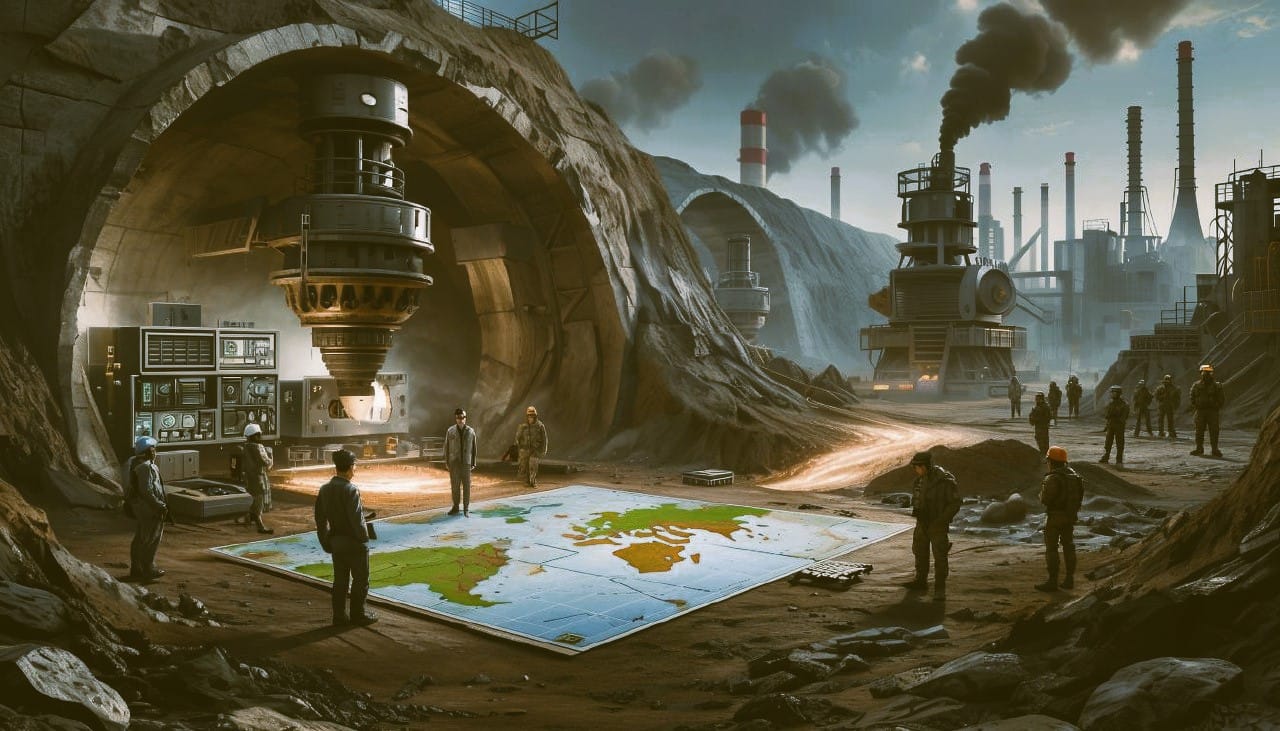The Rare Earth Battle Behind the Russia-Ukraine Conflict

The Russia-Ukraine conflict has become a major global issue, involving not only geopolitics and national security, but also historical grievances and ethnic identity. Among these dimensions lies a less visible but critical struggle over resources — especially the control of key mineral assets.
Resources in Exchange for Aid: U.S. Pressure on Ukraine
Soon after the new U.S. administration took office, it set its sights on Ukraine’s mineral resources. Figures like Donald Trump, U.S. Treasury Secretary Scott Besent, and Special Representative for Ukraine and Russia Keith Kellogg launched a diplomatic offensive through phone diplomacy, social media posts, and visits to Kyiv. On February 3, 2025, Trump stated at the White House that he hoped Ukraine would supply rare earth elements to the U.S. in exchange for aid. On February 8, Ukrainian President Zelensky said he was willing to cooperate with Trump and supply rare earths in return for continued U.S. military support.
However, disagreements between the U.S. and Ukraine over the mineral agreement have been prominent. The U.S. aimed to use such agreements to pressure Ukraine into giving up its mining rights as compensation for aid. Zelensky believed the U.S. was demanding too much without providing adequate security guarantees, thus rejecting the proposed deal. In response, the U.S. intensified pressure: it pushed for direct negotiations with Russia, excluding Ukraine; launched verbal attacks against Zelensky; threatened to cut off Ukraine’s access to SpaceX’s Starlink satellite network; and even voted against Ukraine’s draft resolution at the UN emergency session. Trump stated the U.S. would “take whatever we can get” from Ukraine.
A Strategic Deal is Signed
Under this pressure, on May 1, 2025, Ukraine’s First Deputy Prime Minister and Minister of Economy Yulia Svyrydenko signed the U.S.-Ukraine Reconstruction Investment Fund Agreement with Treasury Secretary Besent. On May 8, the Ukrainian parliament (Verkhovna Rada) approved the U.S.-Ukraine mineral deal with 338 votes in favor. On May 12, President Zelensky signed a decree approving the agreement.
Why Rare Earths Matter to the United States
As the world’s largest industrial nation, rare earths are vital to the U.S. These 17 elements are essential in modern high-tech industries, including military products, clean energy, electronics, and aerospace. Currently, the U.S. heavily relies on China for rare earth imports. China controls 60–80% of global rare earth production and up to 90% of processing. According to the U.S. Geological Survey (USGS), in 2022, 74% of U.S. rare earth imports came from China. Even when the U.S. mines rare earths domestically (e.g., California’s Mountain Pass), the concentrates are often shipped to China for processing.
In fields like high-performance magnets, military electronics, and green energy, the U.S., EU, and Japan depend heavily on China’s rare earth supply chain. The U.S. has repeatedly faced “supply cut-off” risks due to tensions with China. During the U.S.-China trade war, rare earths became a focal point, and in 2019, Chinese officials suggested using them as a “weapon” against the U.S. If China were to restrict exports, it could severely impact the U.S. high-tech and defense sectors: American companies like Apple, Tesla, and Microsoft rely on rare earths for critical components (e.g., batteries, magnets, displays), and the military needs them for missiles, radar, and aircraft.

While China’s threat to weaponize rare earths drew attention, such a move could also hurt its own economy. China’s rare earth industry depends on export income, and alternative supply chains are gradually forming worldwide. A total export ban would hurt global markets — and China’s own industry. Nevertheless, as global competition for rare earths intensifies, these minerals have become a major strategic resource — not just in U.S.-China trade tensions but globally.
Ukraine: A New Front in the Global Resource War
Although China dominates global rare earth supply, Western countries — especially the U.S. and EU — have been seeking alternatives to reduce dependency. Ukraine possesses abundant critical minerals such as neodymium, terbium, dysprosium, lithium, and titanium. Its titanium reserves are among the largest globally, and it also has potential in graphite and nickel development.
Ukraine currently controls 75–80% of its national mineral resources. Deposits in Kirovohrad (lithium, zirconium, titanium, uranium), Dnipropetrovsk (uranium, zirconium, titanium), Zhytomyr (beryllium, zirconium, titanium), and Kyiv (titanium, zirconium) are under Kyiv’s control. Despite being near border regions, zirconium mines in Sumy (Bilovodsk, Kolchakovsky) are also under Ukrainian control. Russia controls about 20–25% of Ukraine’s total resources, including lithium deposits in Shevchenkove and KrutayaBalka, and niobium, tantalum, rubidium, and cesium in Mazurovsky and Novopoltavske.
Ukraine joined the EU's European Raw Materials Alliance (ERMA) in 2021, seeking to establish rare earth and mineral supply chains with Europe. That year, Ukraine’s Geological Service signed a cooperation agreement with the USGS to develop and share data on rare earths and lithium, with U.S. technical support. U.S.-controlled institutions like the IMF and World Bank have provided aid while promoting market reforms, privatization, and Western access to Ukraine’s mining sector.
The EU secured access through strategic partnership agreements, while the U.S. used its geopolitical leverage, economic cooperation, corporate investments, and bilateral deals. American and European companies — such as Westinghouse Electric (nuclear fuel), Energy Fuels Inc. (rare earth processing), and TechMet (critical minerals investment) — have shown keen interest in Ukrainian resources. Through the “Minerals Security Partnership” (MSP), the U.S. and allies like Canada, Australia, and Japan are building a non-China strategic alliance. Ukraine is seen as a potential “anchor nation” in this Western supply chain.
Lithium is vital for EVs, smartphones, and energy storage. Ukraine has formed joint ventures with companies like Tesla, Albemarle, and Livent. With projected production of 500,000 tons and lithium carbonate priced at $25,000/ton in 2025, potential revenue could hit $12.5 billion. With U.S. foundations holding 50%, their share would be $6.25 billion.
Niobium and tantalum are widely used in electronics and aerospace. Zirconium is critical for nuclear energy and high-tech. Rubidium, cesium, and strontium serve various high-tech industries. Beryllium is used in aerospace and electronics. Titanium, in which Ukraine is the world’s second-largest reserve holder, is essential to the aerospace industry. U.S. company Tronox is a potential partner. Ukraine's titanium export potential is about 50,000 tons annually, priced at $3,000/ton, totaling $1.5 billion over 10 years — $750 million for U.S. interests.
Uranium is crucial for nuclear power. Ukraine has estimated reserves of 100,000 tons. At $100/kg (U3O8 in 2025), export value reaches $10 billion, with potential U.S. gains of $5 billion.
For rare earths like neodymium and dysprosium, Ukraine’s confirmed reserves are limited, but rock modeling suggests up to 1 million tons of ore containing 3% rare earth content — yielding about 30,000 tons of pure rare earths. At $50,000/ton, export value could reach $1.5 billion, with the U.S. claiming $750 million.
In total, U.S. potential profits from Ukrainian mineral exports could reach $12.75 billion.
Conclusion
This reveals how the U.S. is using the conflict to reshape control over Eastern Europe’s resources, logistics, and political sovereignty. Though full control hasn’t yet been achieved due to the ongoing war, America is already positioning itself to secure Ukraine’s mining rights after the war. Its goal: to integrate Ukraine into the global critical minerals supply network, counterbalancing China’s rare earth dominance.
The U.S. and allies are crafting a “Ukraine Reconstruction Plan,” trading postwar funds and security guarantees for resource development rights — a typical “resources for security” model. Ukraine’s mineral issue is not just economic; it’s part of a global resource war. The U.S. aims to ensure that key inputs for high-tech and defense are no longer controlled by geopolitical rivals. Ukraine is both a front line against Russia and a new testing ground for decoupling from Chinese resources. Though not a current U.S. supplier, Ukraine is poised to become a key link in the America-led “de-Chinafied” rare earth chain. If the U.S. successfully gains mining rights, it will gain greater autonomy and geopolitical leverage in the global critical minerals race.











